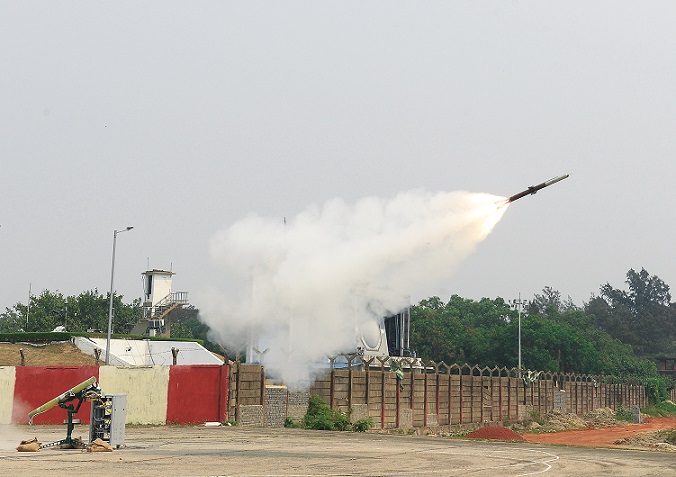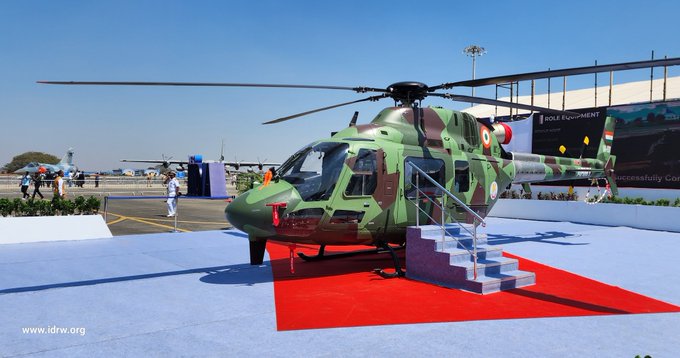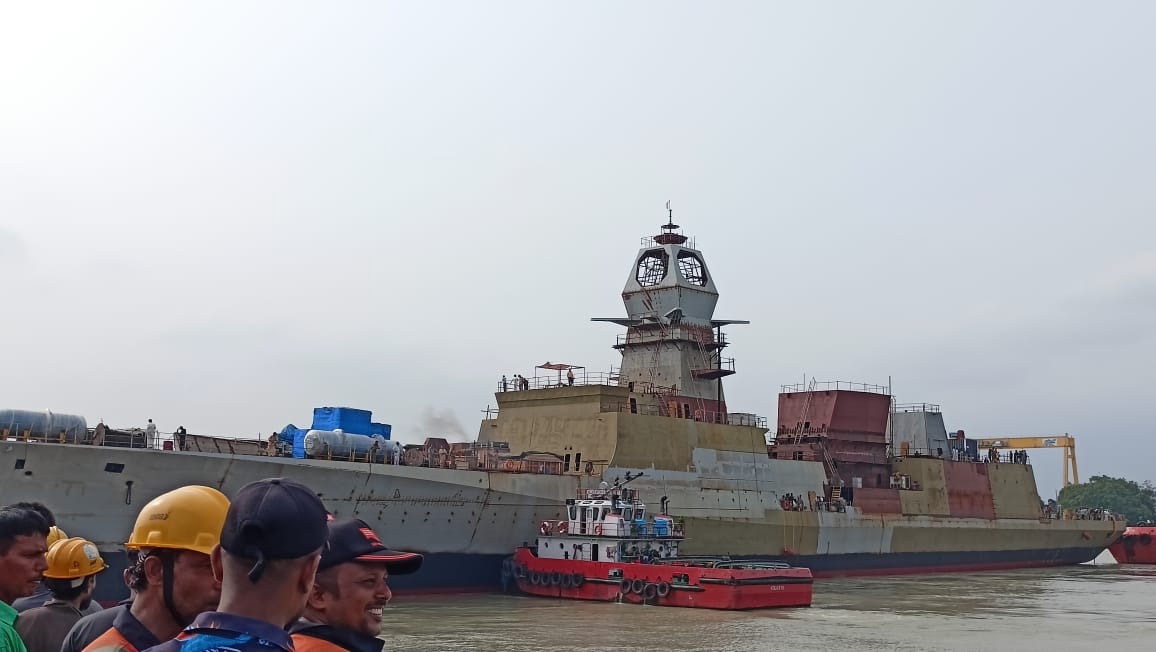SOURCE: IANS


As of January 31, a total of 144 fishermen from Gujarat remain in Pakistani jails, the state government informed the Legislative Assembly on Wednesday. In the one year from February 1, 2023, to January 21, 2024, Pakistan released 432 Gujarat fishermen. However, no fishermen have been released since then.
The number of arrests of Gujarat fishermen by Pakistan has drastically decreased, the government said. Between February 1, 2023, and January 31, 2024, only nine Gujarat fishermen were detained by Pakistani authorities. In the following year, 13 fishermen were arrested, marking a slight increase.
Continue readingSOURCE: RAUNAK KUNDE / NEWS BEAT / IDRW.ORG


The Aeronautical Development Agency (ADA) and Hindustan Aeronautics Limited (HAL) are embarking on an ambitious initiative to integrate the Tejas MkII fighter jet with semi-autonomous unmanned aerial vehicles (UAVs), commonly referred to as CATS Warrior “loyal wingmen.” This cutting-edge project aims to leverage advanced artificial intelligence (AI) technologies for real-time coordination and mission execution between manned and unmanned platforms.
Equipped with state-of-the-art AI, these drones will seamlessly collaborate with the Tejas MkII, sharing mission data and dynamically adapting to evolving combat scenarios. This capability is particularly valuable in high-threat environments, where coordinated manned-unmanned operations can outmanoeuvre and overwhelm adversaries.
Continue readingSOURCE: RAUNAK KUNDE / NEWS BEAT / IDRW.ORG


The Indian Navy has expressed interest in the Defence Research and Development Organisation’s (DRDO) Very Short Range Air Defence System (VSHORADS) to bolster the defensive capabilities of its frontline warships. This advanced system, originally designed for land-based applications, is being considered for adaptation as a Close-In Weapon System (CIWS), enhancing the Navy’s ability to counter a wide range of aerial and surface threats.
The VSHORADS is a man-portable air defence system (MANPADS) equipped with advanced technologies, including a dual-band infrared seeker and a lightweight design for high mobility. When modified for naval applications, the VSHORADS-based CIWS will provide an additional layer of defence, complementing existing missile systems like the Vertical Launch Short Range Surface to Air Missile (VL-SRSAM).
Continue readingSOURCE: RAUNAK KUNDE / NEWS BEAT / IDRW.ORG


The Indian Navy is set to bolster its underwater capabilities with plans to equip three additional Enhanced Scorpene-class submarines with advanced submarine-launched missiles and integrate them with unmanned underwater vehicles (UUVs). These submarines will be procured from Mazagon Dock Shipbuilders Limited (MDL) under Project-75, showcasing a significant step forward in India’s naval strategy and technological integration.
The Enhanced Scorpène-class submarines, an iteration of the Kalvari-class already in service, are designed to offer superior stealth, endurance, and combat capabilities. The introduction of submarine-launched missiles marks a strategic enhancement, providing the Indian Navy with greater tactical flexibility and the ability to engage surface and land targets from underwater, thereby extending the reach and impact of naval operations.
Continue readingSOURCE: AFI


India’s ambitious Light Utility Helicopter (LUH), developed by Hindustan Aeronautics Limited (HAL), has hit turbulence amid revelations of unresolved design issues flagged by a senior experimental test pilot (ETP). Capt K.P. Sanjeev Kumar, a former Indian Navy test pilot and prolific aviation blogger, detailed these concerns in a March 2025 post on his website, www.kaypius.com. Drawing from confirmed sources and personal interactions, Kumar recounts how a veteran IAF test pilot, employed by HAL, escalated serious safety concerns about the LUH—particularly its autorotation and directional stability—to the company’s leadership as early as November 2023. Despite internal reviews and customer demonstrations at Aero India 2025, these issues remain unaddressed, casting a shadow over the program’s credibility and raising questions about the certification process.
The whistleblower, described as a senior IAF veteran and ETP with deep ties to the LUH program, first raised red flags early in its development. According to Kumar, the pilot warned HAL officials of “serious design issues” that threatened the helicopter’s safety and performance. As HAL prepared to sign a contract for 12 Limited Series Production (LSP) units in 2023—part of a broader plan to supply 187 LUHs to the Indian Army and Air Force—the ETP escalated his concerns to the Chairman of HAL in November 2023, citing critical gaps in flight testing that had not been resolved.
Continue readingSOURCE: AFI


India is making strides in the realm of stealth technology with the development of an innovative plasma stealth device, a cutting-edge system designed to reduce the radar cross-section (RCS) of military assets. Recent advancements showcased by the country include the use of rectangular and elliptical tiles integrated into plasma chambers, arranged in arrays to generate plasma with precisely controlled parameters. This technology, aimed at absorbing microwave signals, has undergone rigorous testing in both controlled and real-world environments, marking a significant step forward in India’s defense capabilities.
The plasma stealth device operates on the principle of using ionized gas—plasma—to interact with and attenuate electromagnetic waves, such as those emitted by radar systems. By creating a plasma layer around a target, the device can either absorb or deflect incoming radar waves, effectively reducing the object’s visibility to detection systems. The rectangular and elliptical tiles, developed specifically for this purpose, serve as the building blocks of plasma chambers that produce the necessary plasma conditions. These chambers are engineered to optimize the density and distribution of the plasma, ensuring maximum effectiveness in microwave absorption.
Continue readingSOURCE: AFI


India’s defense industry took a bold step onto the global stage at the International Defence Exhibition and Conference (IDEX) 2025, held in Abu Dhabi from February 17-21. Tata Advanced Systems Limited (TASL) unveiled its Light Armoured Multipurpose Vehicle (LAMV) 4×4 for the first time, showcasing a NATO-compliant, indigenously developed platform designed to meet the evolving needs of modern armed forces. The debut has already generated significant buzz, with inquiries pouring in from multiple Middle Eastern and African nations, signaling a promising export trajectory for this versatile armored vehicle.
The LAMV’s unveiling at IDEX 2025 marked a milestone for TASL, a key player in India’s burgeoning defense sector. Designed to blend mobility, protection, and adaptability, the 4×4 vehicle was pitched as a game-changer for missions ranging from reconnaissance to troop transport and tactical operations. With a sleek, modular design and a gross vehicle weight of 10,200 kilograms, the LAMV offers ballistic protection up to STANAG 4569 Level 2 and mine resistance at Levels 2a and 2b—capable of withstanding small arms fire and explosive threats. Its air-transportable frame and maximum speed of 100 kmph further enhance its appeal for rapid deployment in diverse terrains.
Continue readingSOURCE: AFI


The Indian Navy is poised to enhance its maritime prowess with the addition of two advanced stealth frigates, INS Himagiri and INS Udaygiri, as part of Project 17A. These state-of-the-art warships, belonging to the Nilgiri-class, are set to significantly elevate the Navy’s combat capabilities across multiple warfare domains, including anti-air, anti-surface, and anti-submarine operations. Their induction underscores India’s growing naval strength and commitment to self-reliance in defense manufacturing.
Built with an impressive 75 percent indigenous components, INS Himagiri and INS Udaygiri exemplify the success of India’s “Make in India” initiative. Constructed under Project 17A—a ?45,000-crore endeavor to deliver seven stealth frigates—these warships are being crafted by Mazagon Dock Shipbuilders Limited (MDL) in Mumbai and Garden Reach Shipbuilders & Engineers (GRSE) in Kolkata. The high level of indigenization reflects a maturing defense ecosystem, with local industries supplying critical systems, from propulsion to weaponry.
Continue readingSOURCE: AFP


France’s Finance Minister said Tuesday that his country was opposed to seizing frozen Russian assets to fund military aid for Ukraine, arguing the move would violate international agreements.
Tapping into more than 200 billion euros ($216 billion) in frozen Russian assets has been proposed as a way to bridge the large gap in defense budgets as Europe takes on a greater role in Ukraine’s defense amid uncertain U.S. support under President Donald Trump.
Continue readingSOURCE: IDRW.ORG


In a setback for the U.S.-backed Stryker Infantry Fighting Vehicle (IFV), reports have emerged of its underwhelming performance during high-altitude trials in Ladakh, conducted under the supervision of the Indian Army on behalf of General Dynamics Land Systems-Canada. While official details of the trials remain closely guarded, sources close to the Indian Army have shared revealing insights with idrw.org, painting a picture of significant operational challenges that could impact the Stryker’s prospects in India’s mechanized infantry modernization plans.
The trials, conducted in late 2024, have spotlighted the vehicle’s struggles in the rugged, oxygen-scarce terrain of Ladakh, contrasting sharply with the performance of India’s indigenous Wheeled Armoured Platform (WhAP) 8×8 in similar conditions.
Continue readingSOURCE: IDRW.ORG


India’s aerospace ambitions took a significant step forward with the development of the Hansa-NG (New Generation), an indigenous all-composite light aircraft designed by the Council of Scientific and Industrial Research-National Aerospace Laboratories (CSIR-NAL). Touted as India’s first aircraft in the CS-VLA (Certified Special Very Light Aircraft) category, the Hansa-NG is poised to revolutionize ab initio flight training, sports flying, and hobby aviation.
However, its journey hit a turbulence recently when the engine manufacturer, Rotax, hesitated to supply its advanced engines, citing potential military applications in UAVs or large drones. While this challenge has been successfully negotiated for now, it underscores the complexities of indigenous aerospace development in a globalized supply chain.
Continue readingSOURCE: AFI


India’s defense landscape is witnessing a seismic shift with the ongoing in-flight trials of the Astra MkIII, now officially christened “Gandiva” after the legendary bow of Arjuna from the Mahabharata. Powered by a Solid Fuel Ducted Ramjet (SFDR) propulsion system, this beyond-visual-range (BVR) air-to-air missile promises to redefine aerial combat for the Indian Air Force (IAF).
Coupled with the imminent integration of upgraded Gallium Nitride (GaN)-based Active Electronically Scanned Array (AESA) radars on the Tejas MkII and Advanced Medium Combat Aircraft (AMCA), Gandiva threatens to erode the Dassault Rafale’s long-held technological edge—its Meteor missile—in the IAF’s Multi-Role Fighter Aircraft (MRFA) tender for 110 jets. As indigenous innovation accelerates, the Rafale’s once-unassailable selling point may no longer hold sway.
Continue readingSOURCE: AFI


In a recent interview with a Pakistani news channel, Air Commodore Nouman Ali Khan, a decorated Pakistan Air Force (PAF) pilot credited with downing an Indian MiG-21 Bison in the 2019 aerial clash, provided a rare glimpse into the Rules of Engagement (ROE) governing that high-stakes encounter. Khan, famed for his role in Operation Swift Retort on February 27, 2019, stated that PAF’s ROE permitted the downing of Indian aircraft only if they attempted to cross the Line of Control (LoC) from Indian-controlled territory into Pakistan-occupied Kashmir (PoK).
He confirmed the shootdown of a MiG-21 that crossed into PoK airspace and claimed a second Indian jet, a Su-30 MKI, was also downed—albeit on the Indian side of the LoC after it approached the boundary. This admission raises questions about whether the PAF breached its own ROE, potentially handing India a strategic advantage in future air skirmishes by justifying a broader IAF response.
Continue readingSOURCE: AFI


The fate of India’s Dhruv Advanced Light Helicopter (ALH) fleet remains in limbo as the three-week timeline promised by Hindustan Aeronautics Limited (HAL) to determine its future expired on Monday, March 3. The fleet of approximately 300 choppers, a mainstay of the Indian armed forces and Coast Guard, has been grounded since January 5 following a fatal crash in Gujarat. With the eagerly awaited probe report still pending, questions persist about the operational readiness of this critical asset and the next steps for its return to service.
The grounding was triggered by a tragic incident involving an Indian Coast Guard ALH Dhruv Mk III helicopter, which crashed near Porbandar Airport on January 5, 2025. The accident claimed the lives of three crew members, prompting HAL to suspend operations of the entire fleet—spanning the Army, Navy, Air Force, and Coast Guard—pending a thorough investigation. This marked the second fleet-wide grounding in two years, raising fresh concerns about the reliability of the indigenous helicopter, which has been in service since 2002.
Continue readingSOURCE: AFI


In a significant boost to India’s defense capabilities, Prime Minister Narendra Modi is set to lay the foundation stone for a state-of-the-art missile testing range in Nagayalanka, Andhra Pradesh. Valued at ?20,000 crores, this cutting-edge facility, developed by the Defence Research and Development Organisation (DRDO), is poised to become a cornerstone of India’s indigenous missile development program. The site will specialize in testing advanced surface-to-air missiles (SAMs) and anti-tank missiles, reinforcing India’s growing stature as a global defense powerhouse.
Located along the coastal region of Krishna district, the Nagayalanka testing range is designed to meet the demands of India’s rapidly expanding missile arsenal. The facility will provide a controlled environment for live-fire trials, data collection, and performance evaluation of next-generation missile systems. With a focus on surface-to-air and anti-tank platforms, it will support the development of critical technologies aimed at countering aerial threats and armored assaults—key priorities for India’s armed forces amid evolving regional security challenges.
Continue reading